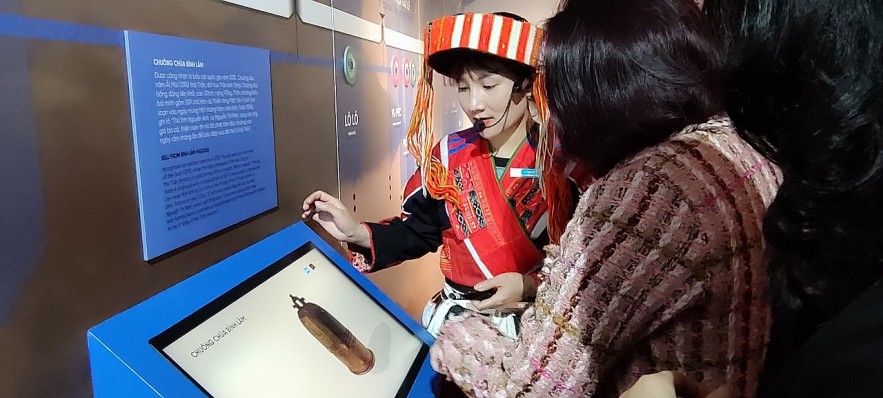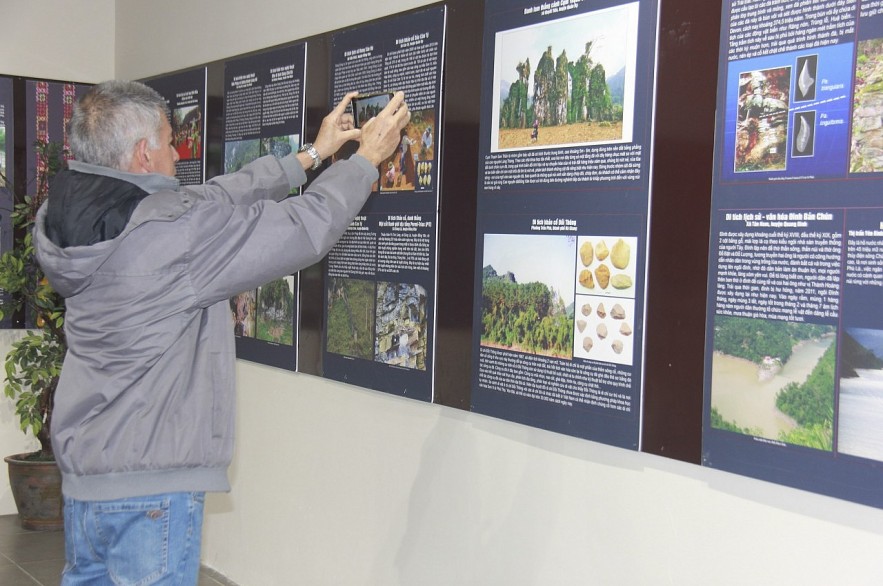Digitizing Museums – Captivatingly Showcasing Ha Giang’s Beauty to Visitors
 |
| Tour guide Le Thi Ngoc Anh guides visitors to experience the sound of the bell of Binh Lam Pagoda, a national treasure, just through touching the screen. (Photo: Minh Thai) |
On the afternoon of March 14, a group of about 20 people departed from Hanoi to visit Ha Giang Museum (No. 148 Tran Hung Dao street, Nguyen Trai ward, Ha Giang city, Ha Giang province).
The first place the group stopped was the reception area with panels arranged according to algorithm, in front were the words “Ha Giang Museum,” behind were images of famous places, and beautiful landscapes of the province. The colors and patterns of the panels evoke the presence of ethnic groups in a common space, inspired by the colors on the costumes of ethnic communities in Ha Giang.
Wearing traditional costumes of the Pa Then ethnic group, Le Thi Ngoc Anh, tour guide of Ha Giang Museum, introduced to visitors the exhibits at the museum.
With the theme “Ha Giang’s historical milestones,” the first floor displays about 50 original artifacts, including many fossilized marine creatures, limestone sediments dating from 500 million to 5 million years ago, and traces of primitive humans.
Many images and artifacts about the settlement process of ethnic groups in Ha Giang, the struggles to protect the Fatherland, and border security from the 10th century until the period of resistance against the French and Americans, and the war to protect the northern border are also displayed here.
The 2nd floor is an exhibition space with the themes of Three Ecological Regions, Diverse Culture, and Building a New Life.
With a large curved screen, visitors feel like they are immersed in the natural landscape in three ecological regions.
In particular, visitors can learn, explore, and interact with diverse flora and fauna, rich natural landscapes, and attractive tourist attractions.
Next is the diverse cultural display space, home to 19 ethnic groups.
From two touch screens and images and artifacts, visitors can discover the most typical cultural features of the ethnic community such as Gau Tao festival, the weaving profession of the Mong people, and Long Tong festival.
In addition, the museum also displays and introduces a number of traditional crafts, including blacksmithing, silver carving, carpentry, paper making, and weaving.
Through the interactive screen system and documentary film discs, viewers have an overview of the intangible cultural heritages.
The final space of the museum has the theme “Building a New Life”, including images of typical construction projects, examples of good people and good deeds in Ha Giang.
They show that the development from the poorest province in the country has now integrated with the general development of the whole country.
 |
| Moises Perez Mokk was impressed with the historical and cultural relics in Ha Giang. (Photo: Minh Thai) |
According to Moises Perez Mokk, reporter of Prensa Latina – Latin American News Agency, the museum tour brought him interesting experiences, helping him understand more about the history of Vietnam and the land of Ha Giang.
He was impressed with the museum’s application of digitalization with 3D mapping screens, large Panorama screens, and interactive artifact screens.
They helped him experience the historical values and traditional cultural identities of the ethnic groups in Ha Giang province most authentically.
Thanh Nga, a member of the Hanoi delegation, also expressed her interest in experiencing artifacts through digital devices.
“Just by touching the image of the bronze bell on the screen, I can hear its ringing sound, and see specific information about the artifact,” she said.
Tour guide Le Thi Ngoc Anh said that the museum’s display idea was designed by a French expert, and a group of colleagues knowledgeable about the customs and social traditions of Ha Giang.
Instead of displaying artifacts in large, dense quantities over time, the museum chooses typical artifacts. This created emphasis on historical landmarks, helping visitors have an overall view.
At the display booths, an overview message about the land and people of Ha Giang is explored through topics supported by technological devices.
“We also coordinate with schools to organize experiential activities at the museum including folk games, bamboo dance, pounding rice and painting.
This thereby contributes to educating students about traditions and preserving historical values. Thanks to many improvements in display technology, combining tradition and modernity, the museum attracts more visitors of all ages to learn, visit and experience,” Ngoc Anh said.
|
Ha Giang Museum is open from Tuesday to Sunday every week, morning from 8 a.m. to 11 a.m., afternoon from 2 p.m. to 5 p.m. For children from 6 years old to under 16 years old, the fee is VND10,000 (US$0.4)/person/time, for students 16 years and older, VND15,000 (US$0.61)/person/time, for adults VND30,000 (US$1.21)/person/time. |
The post Digitizing Museums – Captivatingly Showcasing Ha Giang’s Beauty to Visitors appeared first on Vietexplorer.com.
Nhận xét
Đăng nhận xét